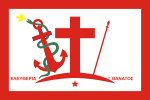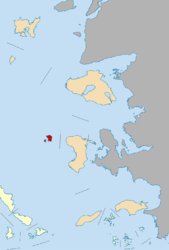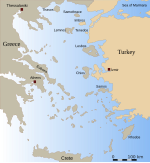
Konstantinos Kanaris, also anglicised as Constantine Kanaris or Canaris, was a Greek statesman, admiral, and a hero of the Greek War of Independence.

The Greek War of Independence, also known as the Greek Revolution or the Greek Revolution of 1821, was a successful war of independence by Greek revolutionaries against the Ottoman Empire between 1821 and 1829. In 1826, the Greeks were assisted by the British Empire, Kingdom of France, and the Russian Empire, while the Ottomans were aided by their vassals, especially by the Eyalet of Egypt. The war led to the formation of modern Greece, which would be expanded to its modern size in later years. The revolution is celebrated by Greeks around the world as independence day on 25 March.
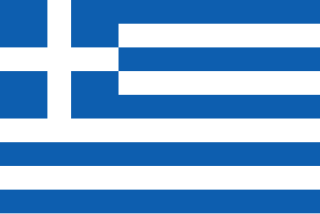
The national flag of Greece, popularly referred to as the Blue-and-White or the Cyan-and-White, is officially recognised by Greece as one of its national symbols and has 5 equal horizontal stripes of blue alternating with white. There is a blue canton in the upper hoist-side corner bearing a white cross; the cross symbolises Eastern Orthodox Christianity. The blazon of the flag is azure, four bars argent; on a canton of the field a Greek cross throughout of the second. The official flag ratio is 2:3. The shade of blue used in the flag has varied throughout its history, from light blue to dark blue, the latter being increasingly used since the late 1960s. It was officially adopted by the First National Assembly at Epidaurus on 13 January 1822.

Eleftheria i thanatos is the motto of Greece. It originated in the Greek songs of resistance that were powerful motivating factors for independence. It was adopted in 1814 by the Filiki Eteria, a secret organization formed specifically for the overthrow of Ottoman rule.
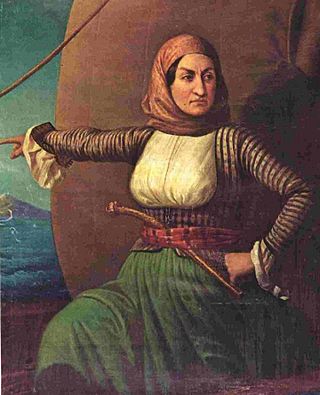
Laskarina Pinotsi, commonly known as Bouboulina, was a Greek naval commander, a woman of the Greek War of Independence in 1821, and considered perhaps the first woman to attain the rank of admiral.
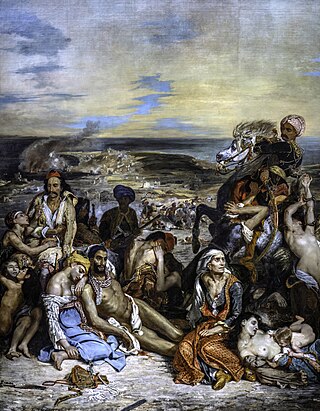
The Chios massacre was a catastrophe that resulted in the death, enslavement, and flight of about four-fifths of the total population of Greeks on the island of Chios by Ottoman troops during the Greek War of Independence in 1822. It is estimated that up to 100,000 people were killed or enslaved during the massacre, while up to 20,000 escaped as refugees. Greeks from neighboring islands had arrived on Chios and encouraged the Chiotes to join their revolt. In response, Ottoman troops landed on the island and killed thousands. The massacre of Christians provoked international outrage across the Western world and led to increasing support for the Greek cause worldwide.

Odysseas Androutsos was a Greek armatolos in eastern continental Greece and a prominent figure of the Greek War of Independence.

The North Aegean islands are a number of scattered islands in the North Aegean Sea, also known as the Northeastern Aegean islands, belonging mostly to Greece and a few of them to Turkey. The islands do not form a physical chain or group, but are frequently grouped together for tourist or administrative purposes. To the south are the Dodecanese islands; and to the west are the Cyclades and Sporades islands.

Iakovos "Yiakoumakis" Tombazis was a Greek admiral, merchant and ship-owner from the Greek island of Hydra who became the first admiral of the Hellenic Navy during the Greek War of Independence.

Nikolis Apostolis was a Greek naval commander, leader of the Psarian fleet during the Greek War of Independence.

The Destruction of Psara was the killing of thousands of Greeks on the island of Psara by Ottoman troops during the Greek War of Independence in 1824.
The Kasos massacre was the massacre of Greek civilians during the Greek War of Independence by Ottoman forces after the Greek Christian population rebelled against the Ottoman Empire.

Christoforos Perraivos was a Greek officer of the Greek War of Independence, member of the Filiki Eteria and author. In non-Greek sources his name is usually found as Per(r)evo(s).
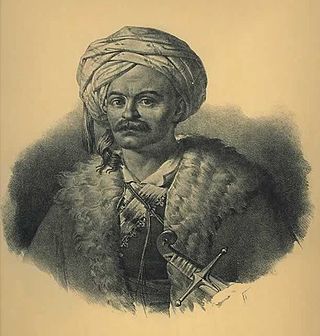
The Chios expedition was an unsuccessful attempt of the regular Greek army and irregular military units for the recapture of Chios island during the final stages of the Greek War of Independence. Chios had participated in the Greek uprising against the Ottoman Empire, but had been captured and its population massacred by the Ottoman fleet in 1822.
Theodoros Negris was a Greek politician.
Marigo Zarafopoula was a person of the Greek War of Independence and member of the Filiki Eteria, a secret 19th-century organization whose purpose was to overthrow the Ottoman rule of Greece and establish an independent Greek state.
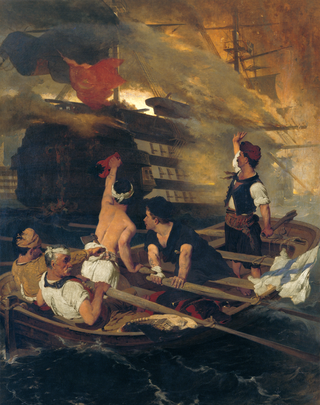
The burning of the Ottoman flagship off Chios took place on the night of 18 June 1822. The event, occurring during the Greek War of Independence, was a reprisal for the Chios massacre which occurred two months earlier. Two thousand Ottoman sailors were killed, as was Nasuhzade Ali Pasha, the Kapudan Pasha of the Ottoman Navy.

Andreas Pipinos was a Greek military officer during the Greek War of Independence.

Domna Visvizi was a Greek maritime captain who fought in the Greek War of Independence. At the outbreak of the war, Visvizi joined her husband Chatzi Antonis Visvizis to fight for the Greek cause onboard the ship Kalomoira. After her husband was killed in battle in July 1822, Visvizi took command of the ship and continued to fight in the war. Among other contributions, Visvizi aided in the Greek capture of the island of Euboea. After running low on funds and being rejected additional funding by the Greek leadership, Visvizi gave over the Kalomoira to the Greek navy in 1824. After the war she was left destitute and with next to no government support lived in poverty until her death in 1850.

The Battle of Chios took place from 24 November 1912 to 3 January 1913 during the First Balkan War. It resulted in the capture of the eastern Aegean island of Chios by the Kingdom of Greece, ending almost 350 years of rule by the Ottoman Empire.

